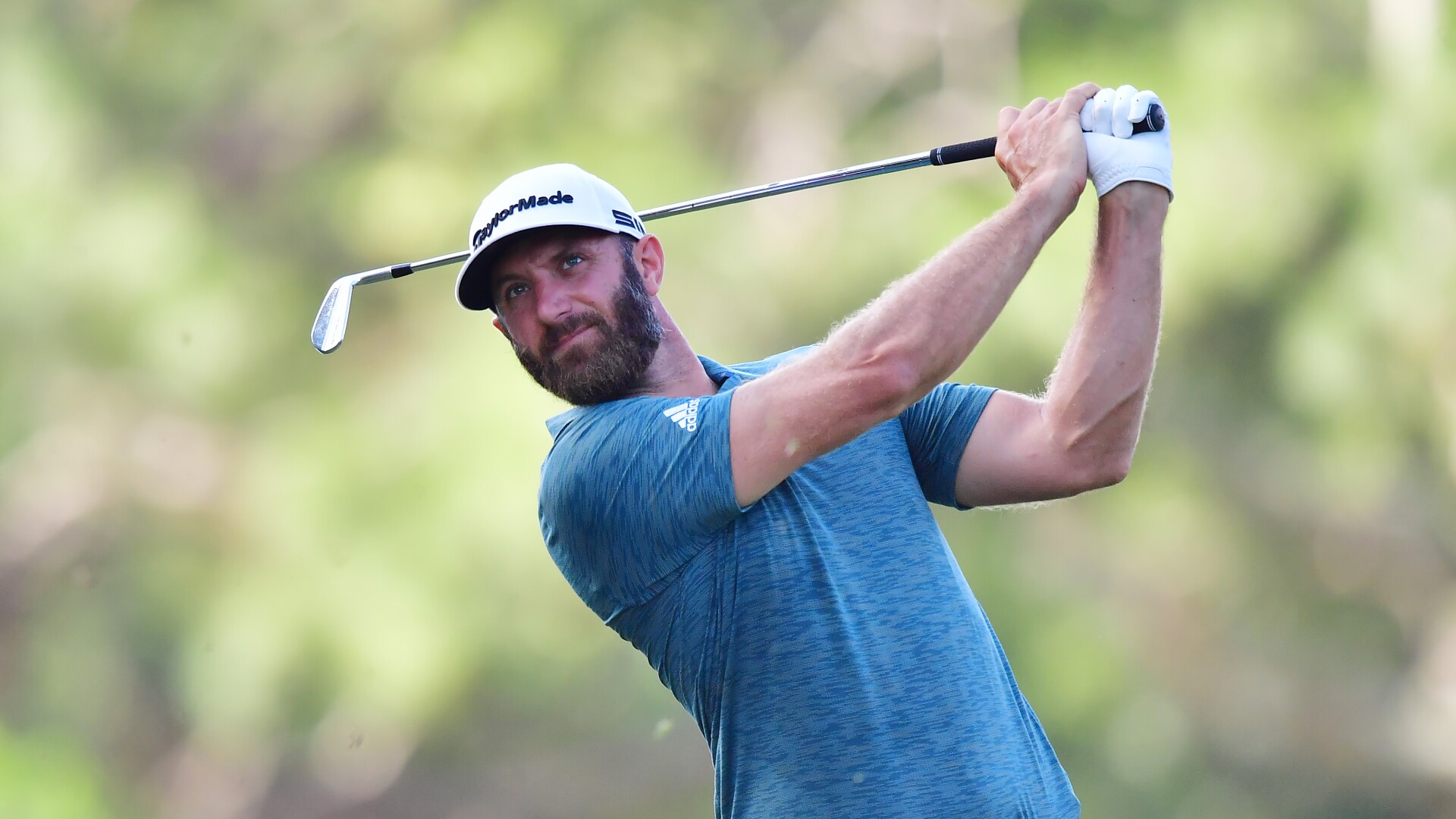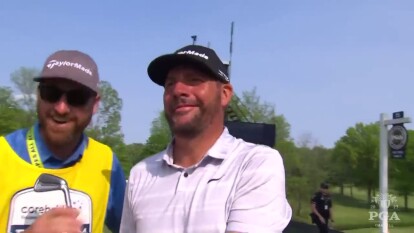The stories are true.
Biff Lathrop heard about them and Chris Miller saw them play out in person in Irmo, South Carolina – a two-and-a-half-hour drive from The Ocean Course on Kiawah Island.
As a youngster on the outskirts of Columbia, Dustin Johnson won a lot of money for himself and a lot of other golfers at the Mid Carolina Club, where his father, Scott, served as the head professional in the 1990s. Known for his raw power and ability to card rounds in the low 60s on a daily basis at courses throughout his neck of the woods, the current top-ranked golfer in the world was turning heads and filling pockets long before he raised the U.S. Open trophy in 2016 or put on a green jacket at the Masters Tournament in 2020.
“The stories about people betting on him at age 14 or so are definitely true over at Mid Carolina when I was a pro at Timberlake. That happened every Friday — that’s a given there,” Miller said, laughing.
Lathrop, executive director of the Irmo-based South Carolina Golf Association, doesn’t have a personal remembrance of any particular moment involving a young DJ, but he’s been around long enough to hear the tales.
“He was a legend around here before he became a legend around the world,” said Lathrop, whose father, Happ, is regarded by many as “Mr. Golf” in South Carolina after serving as the SCGA’s executive director across four decades.
“I can’t speak on anything he did, like driving a par 5 or anything like that … I just know he took a lot of people’s money at a very young age.”
Those stories and memories flooded the minds of Lathrop and Miller in November as they watched Johnson put his twist on a Masters Tournament unlike any other.
“After Dustin won it and we all got to watch, there’s more people that had never talked about golf who were talking about golf all of a sudden in Irmo,” Lathrop said.
“He was the highlight and I think everybody is really excited for him.”
Miller was one of Johnson’s golf coaches during his time at Dutch Fork High School and the former managing director of the South Carolina Junior Golf Association.
He’ll never forget how he felt on Masters Sunday in 2020 as he watched Johnson become the first South Carolinian to put on a green jacket inside Butler Cabin.
“I can’t speak for everybody, but I think for everybody that knew him in South Carolina, that was one of the best days we’ve had yet,” Miller said.
“Obviously, I was just extremely pumped for him. My wife’s sitting over there and I’ve got tears in my eyes and she’s like, ‘It’s a golf tournament, honey.’ ”
Miller was quick with his response.
“You don’t understand,” he replied. “You don’t know what this one means to this kid. I know what it meant to Dustin. I thought that was pretty cool.”
From cutting his teeth at a driving range that’s now an apartment complex to bringing Augusta’s famed course to its knees, Johnson made it look easy at times. But his path has been paved with hard work and an appreciation for a game that’s forever connected him to his roots in the Palmetto State.
BEAT BALLS UNTIL THE COWS CAME HOME
Johnson’s laid-back demeanor often leads to conversations about his work ethic and how much time he puts into his game.
Johnson has never lacked the drive to get better. He spent countless hours at two spots as he began to get serious about golf: The Club at Rawls Creek and Weed Hill Driving Range.
Luckily for Johnson, they were located across the street from one another.
He’d shut both down many a night and, ironically, both are now closed. But Miller remembers the work Johnson put in at those venues.
“It was a public golf course, and it wasn’t anything special by any stretch. The members called it an outdoor pool hall,” Miller said.
“Dustin was one of the cart guys there, along with a lot of these kids who all played together on all these high school teams. … It seems like they were always there. When they were out of school, they were there from 8 till dark at the golf course or driving range. They just played and beat balls until the cows came home.”
Johnson recalls hitting a seemingly endless supply of balls into Lake Murray from the front yard of a house that belonged to Art Whisnant, his late grandfather.
As Johnson became older and started to play in more events around South Carolina, Miller noticed the growth. He knew this kid had the goods to be something special.
“He was definitely a little bit above the normal, as a special player. It was fun to see the progression,” Miller said.
“He didn’t play a lot of tournament golf compared to some of the other juniors at the time, just due to some family scheduling and how much time he could play. When he did, he was always competitive, and he always could hit it a mile.”
That behind-the-scenes work led to some remarkable feats. Johnson won the Columbia city championship in both of his appearances, but Miller always goes back to an astounding three-day stretch.
“A lot of these kids could go out and shoot 3-, 4-, 5-under par on a given day. Dustin had gone out, and over a three-period day between two golf courses that we had eight miles apart, he had shot 63, 64, 63,” Miller continued.
“He had done that in a week. That kind of sets yourself a little diff erent from what the rest of the guys are doing.”
Johnson also won the state junior championship and finished in the top 10 of the state high school tournament as a seventh-grader. By his senior year, after transferring to Dutch Fork, he helped win the 2002 state championship by 26 strokes in the state’s largest classification.
It was a team, as Miller candidly described it, that “destroyed everybody.”
As part of the SCGA, Miller got to see Johnson and his brother, Austin, play a lot on the junior circuit. The golf was pleasant, but Dustin’s hair during a certain Georgia-South Carolina team match also sticks out in Miller’s memories.
“He had dyed his hair orangish-red and we still have a picture at the golf association offices. It looked hideous, so we gave him a lot of crap about that,” Miller said with a laugh.
“It was not a good look on him, but as a kid he was always extremely quiet. On the high school teams, the guys almost had to really talk him into playing high school golf, and I’m glad they did.”
Despite the hair, Miller knew Johnson was capable of achieving greatness.
“There’s no doubt in the quality of golf that he was playing, but he also worked at it, even at that age. He was at the golf course and practice range every day,” Miller said.
When former Coastal Carolina coach Allen Terrell called Miller to “get some impressions” on Johnson, Miller discussed that three-day stretch in the low 60s.
Johnson later committed to Coastal Carolina and Terrell helped the young golfer go from a “raw” talent to one that was chasing a chance to do it for a living.
HE STILL CALLS HIM ‘COACH’
When asked about his earliest impression of Johnson, Terrell had a one-word answer: “Skinny.”
“He was a really tall, skinny kid back then,” Terrell added. “He hit it further with some speed at an early age; nothing earth-shattering. I’d say a raw junior golfer with a lot of upside.”
So how did Johnson make his way to Conway, S.C., to play for Terrell?
“You’d probably have to ask Dustin that one,” Terrell said, laughing. “I think, maybe, I was just the last man standing. Maybe other schools, and I don’t want to speak for them, may have quit trying. I think maybe they weren’t sure if he was gonna play college golf. His grandmother confirmed to me that he was.
“We were happy that (Johnson’s grandmother) Carole Jones was retiring and moving to Myrtle Beach and there was a connection there. To get a good player, there was some luck involved.”
Jones, who died in 2008, helped Johnson pay for college and financed his junior and amateur careers. Like most grandmothers, Terrell said, she thought Johnson was the best thing in the world.
“Back then we had fax machines, so she was faxing me his results. It really wasn’t about making our team better at the time,” Terrell recalled.
“Of course, we were getting a solid player but it being a South Carolina state school and having a kid from South Carolina that had a lot of upside, it was really about giving a kid a chance. This was late July — we didn’t have scholarships available at that point. I’m trying to convince a good player to come for free in Year 1. Not what I would have wanted, it was just the situation and the timing. Thankfully, it worked out for everyone.”
And so began the tough-love relationship between Johnson and Terrell, who added an element of structure and increased discipline to the young golfer’s life.
“If you get a chance to be around him and Allen Terrell, to this day it’s amazing that there’s still so much respect there. He still calls him, ‘Coach.’ It’s Coach Terrell, it’s not Allen,” Miller said.
“Allen put him on the golf team with a lot of practice regimen and, obviously, didn’t mess much with the golf swing as far as the physicality of it. The regimen, you see where his maturity as a golfer came in and the next thing you know, he’s winning amateur events and it’s like, ‘Now we’re starting to see something.’ ”
By the time he left Coastal Carolina, Johnson had won multiple tournaments as a two-time First Team AllAmerican and led the Chanticleers to a program-best fifth-place finish in the 2007 NCAA Championships.
Today, Terrell is the head instructor for Johnson’s golf school at the TPC Myrtle Beach and is the vice president of Johnson’s foundation, which benefits junior golf with a focus on growing the game in Myrtle Beach and beyond.
“It went from me having to be – probably Dustin would say an asshole – a disciplinarian with structure and stuff like that to a big brother of sorts and a friend,” Terrell said.
“When you’re coaching, everyone has their different philosophies and strategies. I felt more comfortable being at arm’s length with players and not being buddy, buddy. But we’re both quite older now and we’re talking 17 years ago. He can say whatever he wants to me. Whatever he needs, Dustin knows he can always call me.”
MORE THAN A NAME ON A TOURNAMENT
Johnson didn’t “create South Carolina golf.”
“To be fair, there’s a hell of a lot of good players that’s come out of South Carolina before DJ,” Terrell said.
Terrell’s not wrong. Jonathan Byrd, Bill Haas, Lucas Glover, D.J. Trahan, Scott Brown and Kevin Kisner are among the most-recent greats from the Palmetto State. Each of them has won on the PGA Tour, including Glover’s major championship at the 2009 U.S. Open.
“He’s just, right now, the highest-ranked player from South Carolina,” Terrell said.
“I doubt he would want to be appointed … but what he’s meant more to Myrtle Beach and growing the game with what our foundation and the school is doing, he’s made a huge impact.”
Lathrop, who rattled off many of the same names, knows Johnson’s importance at the moment.
“Just seeing his face, we’ve got a picture of him on our wall here of him at one of those junior team matches that he qualified for back in the day,” Lathrop said.
Johnson, who has 24 PGA Tour victories, is also featured on the cover of the SCGA’s Spring 2021 “Palmetto Golfer” magazine.
“I think everybody was aware of Dustin as he’s been coming through the last few years and how well he’s done on the golf course and on the Tour,” Lathrop continued.
“Obviously, when he won the Masters – which is only an hour and 15 minutes from here down I-20 – I think it’s made a little more of a difference. From what I understand, they’re naming a road here in Irmo after Dustin. Apparently, we’ll have a Dustin Johnson Lane or something like that around here pretty soon.”
And every year, Johnson tries to make an appearance at the World Junior Golf Championship, which bears his name, to show his thanks and appreciation for the next generation of golfers.
Johnson swung by TPC Myrtle Beach on March 4 to spend some time at his golf school ahead of the sixth annual event, which has quickly become one of the top junior events in the nation.
“I think it’s just gonna keep coming,” Lathrop said of the 36-year-old Johnson’s role as an ambassador for the game.
“I mean, Dustin’s young and he hasn’t had time to make a stamp on anything but playing golf right now. Most of that stuff comes as you work through your years, so I’m sure he’s got more of that coming in.”
From names on their lockers to placards on the driving range, the tournament provides junior golfers a top-level experience.
“It’s not like somebody just putting their name on something or writing a check and that’s it,” Miller said. “When Dustin’s schedule allows, he comes down. These kids got to hang out and take pictures with the U.S. Open trophy (in 2017). … They make it feel like it is a Tour event.”
Terrell, who said he thinks it’s “relaxing” for Johnson to be at the junior event, noted the consistent commitment to everyone involved with the tournament. Every time Terrell sees Johnson in Myrtle Beach, the coach has “100 things to try and get him to sign for his foundation.”
“I mean, how many Tour players, especially the No. 1 Tour player, take the time?” Terrell asked.
“Most people do something because of ulterior motivation, but there’s nothing he gets from this. He does it because he wants to do it. He’s passionate about this tournament and he wants the kids to know he’s thankful that they decided to play his event.”
Before the Players Championship, Johnson discussed his appreciation for his roots in South Carolina and his tournament in Myrtle Beach.
“I mean I grew up playing golf there. I went to college in Myrtle Beach … so it’s definitely a big part of where I’m at today for sure,” Johnson said.
“It was great to get back up there. … The golf tournament, it’s come a long ways. It’s become one of the best tournaments in the country, so definitely proud of that. For me, it’s just obviously growing up playing the South Carolina Junior Golf Association tournaments, it’s something that I can do to try to give back to junior golf a little bit.”





